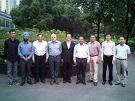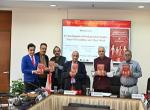Change Language
VIF Delegation’s Visit to China


1. A five member delegation led by the VIF Director Gen N C Vij visited China from 15 to 22 Sep, 2015 at the invitation of the China Institute for International Studies (CIIS). The delegation comprised :-
- Gen NC Vij
- Lt Gen Ravi Sawhney
- Amb TCA Rangachari
- Vice Adm Anup Singh
- Mr Madhav Sharma, CII representative from Shanghai
2. The delegation held discussions with the Centre for South and Southeast Asian Studies (CSAS), Peking University, Beijing; China Institute of International Studies (CIIS), Beijing; Development Research Centre (DRC), Beijing; Shanghai Institute of International Studies (SIIS), Shanghai; Yunnan Academy of Social Sciences (YASS), Kunming.

3. The following points emerged:
- There is extensive and intensive study in a number of Indian languages in Beijing and in some other Universities. There are 11 Universities with Hindi departments with about 500 students. There was considerable scholarship on India and Indian literature in Hindi, Urdu, Bengali, Gujarati, Punjabi, Sanskrit, Awadhi, Pali, and Brij Bhasha. A number of books/translations have been published. They are now compiling a pictorial of I/C contact over 2000 years.
- In comparison, the Indian side noted that the study of China in India lags behind.
- There is great keenness to enhance cultural and educational exchanges. The Chinese side is ready to welcome more Indian students. VIF was invited to participate in the Summer School programme of Beijing University.
- The VIF indicated willingness to host the release of the book on Kabir prepared by a scholar of the CSAS in January 2016. CSAS accepted the invitation. The date will be worked out through further consultations. It was decided to consider an annual conference between the VIF and Beijing University. VIF might also consider attachment of Chinese students for brief periods. It was hoped that100 Indians could be trained in China in the Chinese language to teach in India on return.
- On economic cooperation, obstacles on the Indian side were cited e.g. land and labour reform. The Chinese side was not clear whether India wanted China’s ideas or investment w.r.t Smart Cities. There were many commonalities and prospects of cooperation e.g. joint investments in third countries rather than competition for natural resources.
- There were prospects of cooperation in counter terrorism and de-radicalization.
- On Afghanistan, it was felt that the Af Government was fragile. There was a split between ideological and military wings of the Taliban. Even if an agreement was reached between the Afghan government and the Taliban, it would be difficult to implement or enforce it and so it will be ineffective. Still, the two sides should sit together and even if there were no concessions, continuing talks would mean that the Afghan Government would be able to buy time and get better leverage. The East Turkistan Islamic Movement (ETIM) and the TTP were taking refuge in North and South.
- The manifestation of the ISIS in Afghanistan was not of Syrian origin; it was simply a re-branding of local militant outfits. There was no evidence of any institutional or financial connection. The ISIS had degenerated into third generation militancy i.e. instead of fighting against foreign occupation elements, it was fighting for Islam.
- On OBOR it was stated that China’s aim was to create an integration of economies. India was a ‘key partner’. The issue has been raised with the Indian Government twice: once with the then NSA during the Special Representatives’ meeting at Delhi in Nov 2013 and the second time with the Vice President during the Panchsheel celebrations at Beijing, in Jun 2014.
- A major part involved physical connectivity where we had common ground. In India and in China there was great demand for infrastructure building. The EU was well connected. Asia was no comparison. This provides great opportunity. Institutional linkages are necessary e.g. customs, finance etc. China is doing a great deal in financial integration through AIIB, Silk Road Fund etc. It was necessary to build people to people and cultural connectivity. China will do all it can to take into account the views of neighbouring countries.
- It was noted that on the Indian side, there was still lack of clarity on what China proposed vis-à-vis India for connectivity. On both occasions that the matter had been raised,, the Chinese side was informed that India could respond only after it received full details of the proposal and its operating parameters. These are still awaited.
- The CPEC, passing as it does through PoK, poses a threat to India’s sovereignty and made it difficult for India to become a partner in the OBOR endeavour.
- The Chinese side acknowledged that the OBOR is still only a thought process officially, no route had yet been chalked out – either on land or at sea. They were waiting for various Governments and Think Tanks around the world to throw up ideas, routes, and infrastructure proposals after which a firm project will emerge. A Think Tank Forum was initiated by China with its inaugural session at Istanbul, in 2014, where Governments, Businesses, and global Think Tanks displayed a lot of enthusiasm in the proposal. The Chinese side reiterated its invitation to the VIF to be part of the Forum.
- On SCO, India joining the SCO, along with Pakistan, was felt to be a major step as India was a key regional player and it would boost the capability of the SCO to deal with terrorism and energy etc. India and China were the biggest consumers of energy in the region and coordinating their positions would be mutually beneficial. They had no say presently in supplies or pricing or other matters relating to energy security. Europe has coordination; Asia none. Stability in the Middle East and Central Asia are relevant for energy supplies. India and China could jointly contribute to global safety in energy. We could also work to have direct cooperation. For instance, the Chinese side suggested that Russian energy could flow to India through a pipeline via Xinjiang. This would circumvent the Malacca Straits and would be mutually beneficial.
- On Bilateral Trade, it was noted that there were prospects of expansion from the current USD 100 billion to USD 150 billion by 2020.
- The Indian side pointed out that the persistent trade imbalance was unsustainable. The Chinese response was that some more commodities (other than iron ore), or products could be offered to improve matters. For greater FDI from China, more interaction between businesses was needed. The Chinese side pointed to the problems faced by Chinese companies in doing business in India. The current system of clearances and joint venture promotion needed to be improved. The CII underscored the need for greater CEO-level interaction and indicated willingness to host such meetings. This was appreciated. In Yunnan, there was keenness to have Indian pharma companies set up operations. It was agreed to have more contacts in this regard.
- There was general agreement that the Border issue should be resolved early. It was stated also that it would be preferable if this issue was discussed at the SR/diplomatic levels without too much publicity. In this instance, transparency might prove to be a hindrance as it was linked to peoples’ sentiments and the media in both countries tended to play up with adverse effects.
- On UNSC Reforms, there was consensus on the need for reforms. The Chinese side felt that India should go it alone for permanent membership rather than going in the G-4 mode, in particular with Japan. China could not support PM Shinzo Abe’s policies. The Indian side pointed out that in the absence of a public endorsement of the Indian candidature by China, it would be difficult to consider China’s conditions. In any case, Japan also had its supporters. India needed the support of those countries too.
- On people to people contact, there was consensus that relations would improve with greater contact through cultural exchanges, arts, and encouragement for tourism. The Indian side mentioned disparity in tourist exchange. While 700,000 Indian tourists visited China, only 100,000 Chinese tourists visited India last year. This imbalance must be corrected. Unless enough Chinese are encouraged to visit India there would not be enough awareness about India. The Chinese side mentioned the difficulty in getting Indian visa. It was felt that both Governments should ease visa processes and be extend e-visa facility for all purposes including businesses and conferences.
- On the current state of the Chinese Economy, the Chinese side stated that during the last three decades, China had seen a robust 9.8% growth rate. High levels of investments and high levels of exports. This growth had helped 700 million Chinese to urbanize and improve their quality of life. With wages having moved upwards, the Chinese manufacturing sector is not as competitive as it used to be. Additionally, due to the global economic slide, China’s exports are suffering. Now the Government was pursuing a different strategy including increased privatization for market competition. For the foreseeable future, the economy will grow only at about 7% - the “new normal”. As for the stock market, this should be seen as part of new reforms where the market will play a more prominent role. The Government has intervened in the stock market to stabilize the market and the banks’ exposure. People’s confidence is getting restored. There is already a recovery to be seen. There should be no adverse impact on bilateral economic engagement. The commodity demand from India is still at the same levels as before. It was suggested that Indian business houses should participate in the China Development Forum held annually in March. This would enable Indian businesses o better understand China’s policies and to explore opportunities for business in China. The CII assured that invitations, when extended, would be responded to.



Event Date
September 15, 2015
Contact Us





